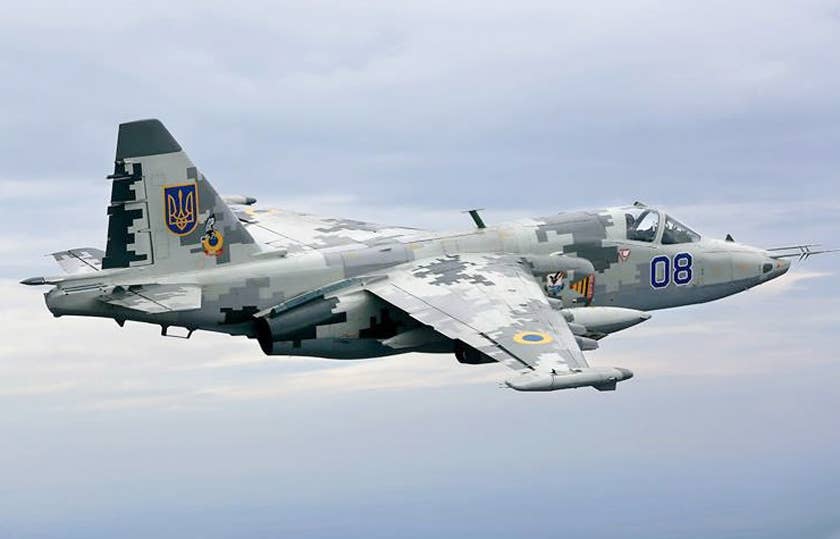The first images of the Ukrainian Air Force’s Su-25 Frogfoot attack aircraft, armed with air-launched Zuni rockets supplied by the United States, have surfaced on social media.
The Associated Press released a series of photos on May 10, showcasing at least four Su-25 Frogfoot attack aircraft armed with Zuni air-launched rockets in 4-shot LAU-10 pods.
These images quickly caught the attention of social media users, as they marked the first instance of clear and visible evidence of these rockets being fitted on Ukrainian fighter jets.
The Su-25 aircraft depicted in the images are allegedly affiliated with the 299th Tactical Aviation Brigade of the Ukrainian Air Force.
In the ongoing war between Russia, and Ukraine, the Su-25 Frogfoot fighter jets have played a significant role in targeting Russian positions using outdated Soviet-era rockets.
#Ukraine: The first images of Ukrainian Su-25M1 "21 Blue" and other jets of the 299th Tactical Aviation Brigade in flight with 🇺🇸US-supplied Zuni 5" Rockets in four round LAU-10[C/D]/A launchers.
Via @Ukraine_AF https://t.co/oiRXAqLvNU pic.twitter.com/FQ8nTWuepy
— 🇺🇦 Ukraine Weapons Tracker (@UAWeapons) May 10, 2023
According to defense analyst Mike Yeo, the photo compilation released by the Associated Press (AP) reveals multiple Su-25 aircraft belonging to the Ukrainian Air Force’s 299th Tactical Aviation Brigade.
Specifically, Yeo identified four distinct Su-25s with the designations 21 Blue, 51 Blue, 58 Blue, and 7x Blue.
The images of Zuni rockets in Ukraine first surfaced on May 1. Those pictures depicted a military cart transporting active Zuni rockets alongside a Ukrainian Air Force Su-25 aircraft adorned with distinct “digital” camouflage and displaying blue and yellow identification panels.
The rockets positioned closest to the camera have been festooned with motivational slogans written in Ukrainian. This practice of applying such slogans on air-launched weapons is not new and has been observed on previous occasions.

In January, the transfer of 4,000 Zuni rockets to Ukraine was confirmed as part of a $3-billion military aid package from the Pentagon.
The aid package included 50 M2 Bradley infantry fighting vehicles, which have also begun to arrive in Ukraine.
American 5-Inch Zuni Air-Launched Rockets
The Zuni rocket comprises a standardized rocket motor and a main section that can be combined with various warheads.
Over time, the significance of the basic Zuni rocket decreased in the US arsenal as more accurate guided ordnance, including laser-guided rockets, was introduced. Eventually, the Zuni rocket was completely phased out.
During World War II, the United States military introduced 5-inch rockets as armaments for tactical aircraft. These rockets were a progression from an earlier 3.5-inch air-launched anti-submarine rocket employed by the US Navy.
The 5-inch Forward-Firing Aircraft Rocket, commonly known as FFAR, was created by combining the motor from the anti-submarine rocket with the warhead from an anti-aircraft shell.
This weapon was put into active service in the latter part of 1943, marking a significant milestone in aerial warfare.
The 5-inch High-Velocity Aircraft Rocket, or HVAR, was an upgraded weapon that outperformed its predecessor. Equipped with a larger motor, it boasted enhanced speed and destructive capabilities, making it an effective weapon on the battlefield.
These weapons, the predecessors of the Zuni rocket, were developed by the US Navy in the early 1950s.
They underwent a notable modification with the introduction of folding fins, which enabled streamlined external pods to carry multiple rockets. As a result of this innovation, the weapon’s designation was changed to Folding-Fin Aircraft Rocket or FFAR.
Since its introduction in the late 1950s, the Zuni FFAR has been characterized by its modular design, allowing for the deployment of various warhead types, fuzes, and motors. A typical Zuni rocket measures approximately 110 inches long and weighs slightly over 100 pounds.
During the US involvement in the Vietnam War, a wide array of US Navy and Marine Corps aircraft extensively utilized the Zuni rocket.
However, it became well-known for a tragic event on the USS Forrestal aircraft carrier in July 1967. A Zuni rocket was accidentally fired on the carrier’s deck, resulting in a devastating fire that caused significant damage.
A more modern variation of the Zuni is the Wrap-Around Fin Aerial Rocket or WAFAR variant. These types utilize a redesigned nozzle/fin assembly and a smokeless Mk 71 motor.
- Contact the author at ashishmichel(at)gmail.com
- Follow EurAsian Times on Google News